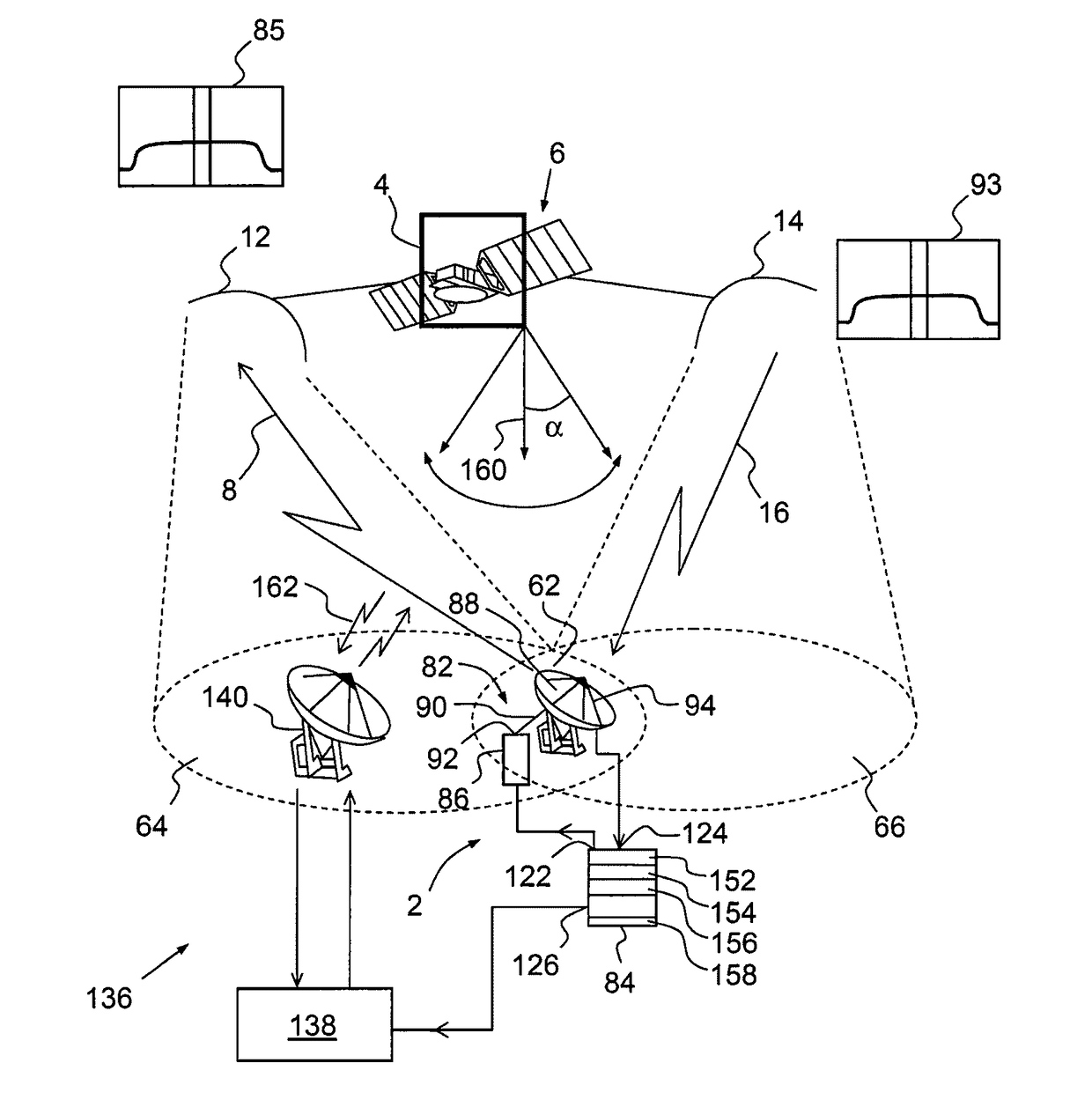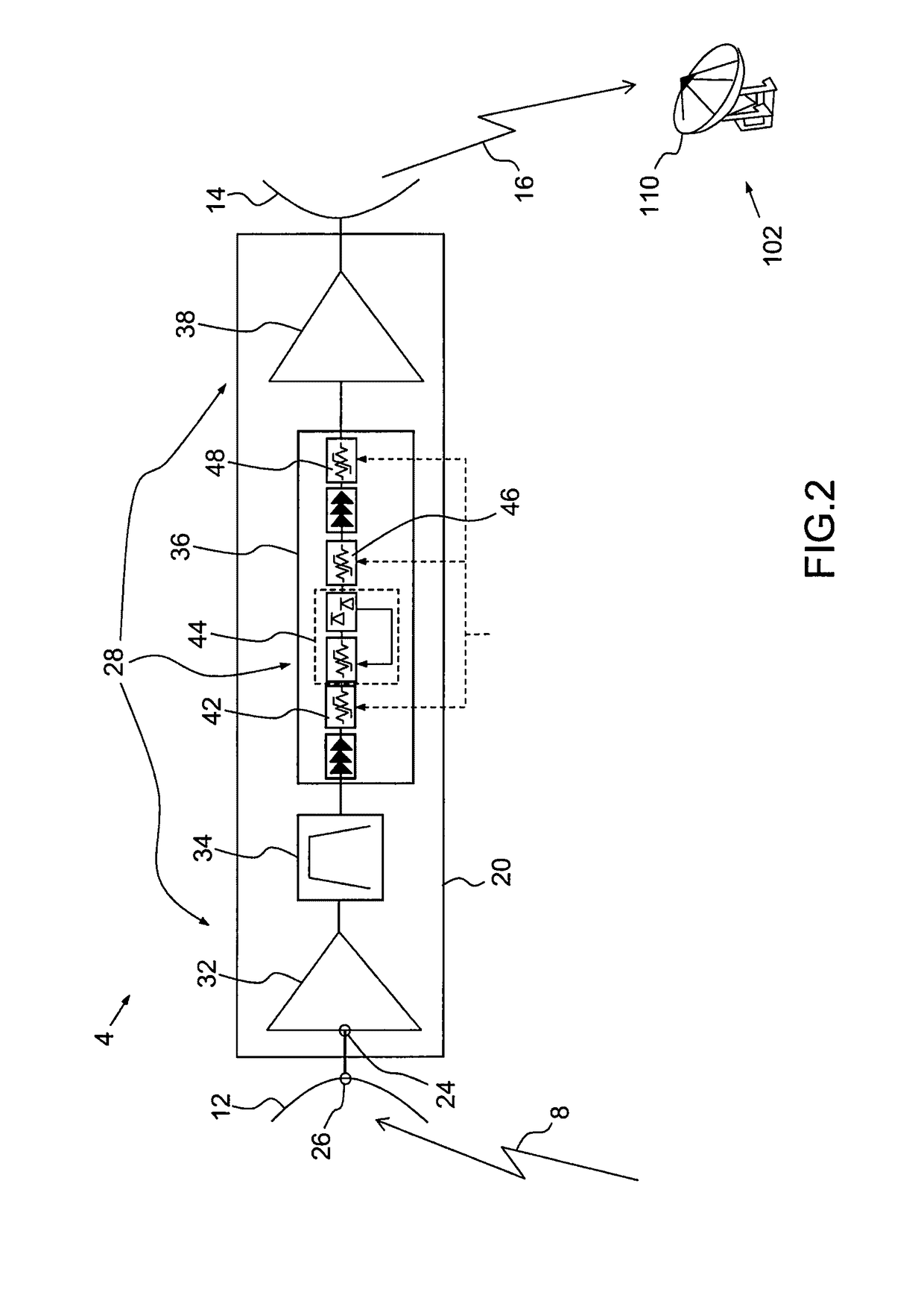Method of characterizing the performance of a payload of a satellite in orbit and associated IoT system
a technology of payload and iot system, which is applied in the direction of cosmonautic vehicles, transmitter monitoring, transmission monitoring, etc., can solve the problems of increasing the complexity of the test system, limiting the testing of the receive antenna, and not being able to test the receive antenna throughout its angular coverag
- Summary
- Abstract
- Description
- Claims
- Application Information
AI Technical Summary
Benefits of technology
Problems solved by technology
Method used
Image
Examples
second embodiment
[0130]According to FIG. 7 and a particular second embodiment of the invention, the characterization of the payload concerns the characterization of an angular diagram or of angular sections of variation of the directivity of the receive satellite antenna 12. A method 322 of characterizing this performance comprises the first step 304 and a set of steps 324, 326, 328, 330, 332, 334, 336, 338.
[0131]In the step 324, the attitude of the satellite and / or of the receive satellite antenna (in the case of an antenna mobile relative to the platform the attitude of which relative to the latter can be controlled) is configured by telecommand so that the receive satellite antenna points toward the test ground station 82 according to a reference pointing angular position.
[0132]In the step 326, the second amplification means 28 of the payload are configured by telecommand at a predetermined first fixed gain that corresponds to a linear mode of operation in an input portion of the transponder corr...
third embodiment
[0140]According to FIG. 8, and a third embodiment, the transponder is assumed transparent and the characterization of the payload concerns the characterization of the gain response of the transponder 20 from its input end to its output end according to a predetermined gain command of the second amplification means 28 for which the transponder 20 operates in linear mode when the ground station 82 generates a test thermal noise the power spectral density of which is equal to the reference power spectral density Dref. A method 352 of characterizing this performance comprises the first step 304 by way of a preliminary step and a set of steps 354, 356, 358 and 360.
[0141]In the step 354, the receive satellite antenna 12 is pointed by telecommand at the test ground station 82 according to a reference pointing direction.
[0142]Then, in the step 356 the second amplification means 28 are configured by telecommand to fix the gain of the transponder at the predetermined gain value compatible wit...
fourth embodiment
[0145]According to FIG. 9, and a fourth embodiment, the transponder is assumed to be transparent and the characterization of the payload concerns the characterization of the frequency response of the gain over the entire band of the transponder according to the same predetermined gain command applied to the second amplification means 28 for which the transponder operates in linear mode when the ground station 82 generates a test thermal noise the power spectral density of which is equal to the reference power density Dref.
[0146]A method 372 of characterizing this performance comprises the first step 304 by way of a preliminary step and a set of steps 374, 376, 378, 380, 382 and 384.
[0147]In the step 374, the receive satellite antenna 12 is pointed at the test ground station 82 according to a reference pointing direction.
[0148]Then, in the step 376, the second amplification means 28 are configured by telecommand to fix the gain of the transponder at a predetermined gain value compati...
PUM
 Login to View More
Login to View More Abstract
Description
Claims
Application Information
 Login to View More
Login to View More - R&D
- Intellectual Property
- Life Sciences
- Materials
- Tech Scout
- Unparalleled Data Quality
- Higher Quality Content
- 60% Fewer Hallucinations
Browse by: Latest US Patents, China's latest patents, Technical Efficacy Thesaurus, Application Domain, Technology Topic, Popular Technical Reports.
© 2025 PatSnap. All rights reserved.Legal|Privacy policy|Modern Slavery Act Transparency Statement|Sitemap|About US| Contact US: help@patsnap.com



